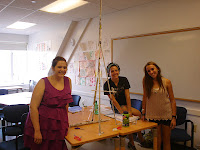
This coming Monday I have about an hour in my Teaching Math/Science class to teach the Earth Science part of the K - 6 science curriculum; clearly not enough time to "cover" or explore everything K - 6 students need to know and understand. So, like each area of the science curriculum for which I have about an hour, we explore a sample topic. (This is pretty much standard procedure for most teacher education programs). I always try to select something from which I think the students would benefit most in terms of the development of both their own understanding and the work they will be doing with K-6 students.
For Earth Science I do an activity with them that helps them develop a better understanding of why it is generally hotter near the Equator and colder near the poles. An activity appropriate for 5/6th grade students. We also explore the reasons for the seasons as well as day and night; all in ths pace of about an hour. The diagram above is typical of what you see in text books and can give rise to all kinds of misconceptions so we do something similar but make it into an activity.
The students sit in a circle and pass a globe around while I shine a flashlight on it from the center of the room. By carefully establishing some activity rules like; the globe is always tilted toward the same wall as it orbits the "Sun", and, the rays from the Sun must be kept horizontal, and,the Earth orbits the Sun and rotates on its axis counter clockwise, we can pretty much develop an understanding of the concepts of insolation, the seasons, and day and night.
We finish off the activity by exploring websites like this one, 24Time Zones.com that gives the time anywhere in the world as well as showing how darkness is coverning the Earth. You can see if it is tomorrow or today somewhere, whether it is day or night, and how long the days are at any location. Websites like these really allow us to help students develop a much more robust understanding of what are pretty difficult concepts.
Hopefully, my students will never teach their students that it is hotter at the equator because it is closer to the Sun; one of the most common misconceptions in the whole universe of science..















